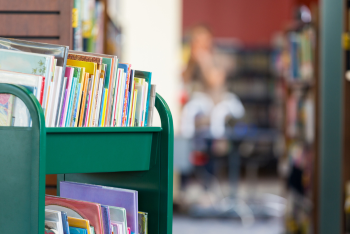By Carol-Lyn McKelvey, FAUSA and AIWC Cologne
“Banning and burning of books is the symbol of tyranny’s fear of the power of the free mind.” – Franz Boas, anthropologist
Book banning in the United States (US) is nothing new. The first book on record to be banned dates back to 1637 when Thomas Morton published New English Canaan and had it promptly banned by the Massachusetts Puritan government.² Unfortunately, attempts to ban and actual bans have grown exponentially in the last few years.
 In 2014, there were 235 attempts to censor books in public schools and libraries, with 183 unique titles challenged. In 2023 there were 938 attempts to censor books, with 4,240 unique titles challenged.³ That’s an almost 400% increase in attempts in just nine years. Starting in the fall of 2021, PEN America started tracking book bans by semester: in Fall 2021 there were 1,383 bans; in Spring 2023 there were 1,841; in Fall 2023 the number took a dramatic leap to 4,349. In total, PEN America recorded nearly 10,000 instances of book bans from June 2021 to July 2023.⁷ With over 10,000 active book bans in 2023–24 alone. Florida (4,500) and Iowa (>3,600) lead the country in number of bans. “The 2023–2024 school year recorded the highest instances of book bans and highest number of unique titles banned – over 4,000 unique titles were removed in over 10,000 instances of book bans.”⁹
In 2014, there were 235 attempts to censor books in public schools and libraries, with 183 unique titles challenged. In 2023 there were 938 attempts to censor books, with 4,240 unique titles challenged.³ That’s an almost 400% increase in attempts in just nine years. Starting in the fall of 2021, PEN America started tracking book bans by semester: in Fall 2021 there were 1,383 bans; in Spring 2023 there were 1,841; in Fall 2023 the number took a dramatic leap to 4,349. In total, PEN America recorded nearly 10,000 instances of book bans from June 2021 to July 2023.⁷ With over 10,000 active book bans in 2023–24 alone. Florida (4,500) and Iowa (>3,600) lead the country in number of bans. “The 2023–2024 school year recorded the highest instances of book bans and highest number of unique titles banned – over 4,000 unique titles were removed in over 10,000 instances of book bans.”⁹
While book bans have always existed in the US, the current uptick in activity is conspicuous. How did we get here? Advocacy groups and state legislators have both played a role. Them reports:
“...three advocacy groups have been particularly active in pushing these bans forward: Moms for Liberty, Citizens Defending Freedom, and Parents’ Rights in Education. The largest by far of the three is Moms for Liberty, which formed in Florida in 2021 and now has 284 chapters in 44 states. The group enjoys the support of some of the most influential Republican politicians; Donald Trump, Ron DeSantis, Nikki Haley, and Vivek Ramaswamy all spoke at the Moms for Liberty conference in July. PEN America’s report found that 81% of all of the school districts in the US that have enacted book bans are in or adjacent to a county where there is an active chapter of at least one of these groups…State legislation, namely ‘educational intimidation bills,’ as PEN America calls them, has also served to accelerate the implementation of school book bans. Broadly speaking, these bills work to indirectly censor school materials by creating a ‘chilling’ effect. This means that much of this legislation (including ‘Don’t Say Gay’) is overly broad or vaguely worded, which leads educators to self-censor for fear of violating the law. The report notes that of the 33 states that have enacted bans this past school year, eight enacted an ‘educational intimidation bill’ that took effect within the past year. A whopping 63% of all book bans recorded in the report occurred in those eight states.”¹
As a part of these issues, a fundamental misunderstanding of how children interact with literature is also at play. From USCDornsife:
“Many adults presume that exposure to particular literary content will invariably produce particular effects.
Christian author and editor David Kopp acknowledged as much when he addressed the controversy around the 1989 children’s book Heather Has Two Mommies.
‘[T]he deeper dilemma for many Christians who oppose this book is often not a theological one, but an emotional one. It has to do with what we fear,’ he wrote on the faith-focused website BeliefNet in 2001. ‘We fear our kids will be indoctrinated somehow. We fear they’ll come to consider homosexuality as normal and then … the part we don’t say … become one.’
Kopp found this fear ‘absurd.’ He insisted that a ‘book, well intentioned or otherwise, isn’t likely to change our child’s sexual orientation.’
Many scholars would agree. Research shows that children’s reading experiences are complex and unpredictable. As scholar Christine Jenkins explains in an article about censorship and young readers, ‘Readers respond to and are affected by texts in ways specific to each reader in the context of a specific time and place.’⁸
Put simply, children co-create their own reading experiences. Their interpretation of books is informed by their personal and cultural histories, and those interpretations may change over time or when readers encounter the same stories in different contexts.”⁸
So why does this matter? People read books for a variety of reasons: to learn something, to escape, to be entertained. Literature and literacy also serves broader purposes, however, by reflecting diversity, building empathy and understanding, and fostering a sense of identity and belonging.⁴ Historically it is the most under-represented and vulnerable among us, seeking to find relatable characters in literature, who have taken the hardest hit. In 2023–24, the books with the most bans included people and characters of color (44%) and books with LGBTQ+ people and characters (39%). Additionally, “nearly 60% of these banned titles are written for young adult audiences, and depict topics young people confront in the real world, including grief and death, experiences with substance abuse, suicide, depressions and mental health concerns, and sexual violence.”⁹ In a study conducted by Study Finds, 50% of girls reported they did not feel represented in the books they read, with over ⅓ of them noting that it seemed boys always had the lead roles. While this study found that over 60% of parents felt their children would read more if there was more representation, another poll found 61% of parents reported that lack of representation in terms of gender and race had “turned their children off to reading altogether.”
The impact of this is far-reaching. “Last year, the National Assessment of Education Progress (NAEP), ‘the nation’s report card,’ showed that not even half (43%) of fourth graders in the US scored at or above a proficient level in reading. And for marginalized students, the numbers are much worse: just 17% of Black students, 21% of Latino students, 11% of students with disabilities, and 10% of multilingual learners can read proficiently by fourth grade.”⁶ While a case could be made that the low scores are part of the ripple effects of COVID that are still being felt educationally, another case can be made that the less children see themselves represented in the reading material they are supposed to learn from, the less motivated they will be to take on this task. It is not a zero sum game, and book bans compound this problem.
So what can you do? First and foremost, staying informed is crucial. Subscribing to Pen America will not only keep you up to date on the current status of book bans, but they also offer resources and virtual events on a variety of topics. Their mission statement reads: “Pen America stands at the intersection of literature and human rights to protect free expression in the United States and worldwide. We champion the freedom to write, recognizing the power of the word to transform the world.”⁷
Another source of agency lies in programs like “Dolly Parton’s Imagination Library.” Inspired by her own father’s illiteracy, Dolly initially started this program in her own county in her home state of Tennessee, sending books to all children from birth to age five, regardless of socioeconomic status. The program has now grown to encompass not only the whole United States, but the UK, the Republic of Ireland, Canada and Australia. Does the country you live in offer a similar program?
Ways to contribute and take action against book banning can be found by connecting with your local bookstores, schools, school districts and libraries. One current effort underway in the US, spearheaded by the American Booksellers Association, is the Set Books Free Project, a “book donation initiative to create a pipeline of banned and diverse books from independent booksellers and their customers to the places experiencing the most bans.” Among other items, they also publish The ABA Right to Read Handbook: Fighting Book Bans and Why It Matters, “a comprehensive guide to resisting the epidemic of book censorship through local organizing and engaged citizenship. The Handbook is designed for the potential advocate who may only have a few hours to spare each month.” Additionally, if your children are looking to get involved, the Brooklyn Public Library Books Unbanned initiative offers banned books to teenagers all over the US (and links to other libraries doing the same), as well as safe spaces for young adults in any country to find like-minded teens. Lastly, keep an eye on FAWCO’s Literacy is our Legacy initiative for upcoming programming linking LioL to the power of libraries worldwide. By tapping into any of the named resources, you will find a plethora of other resources as well.
As dire as book bans have been, are and might be, we must believe and have hope that our collective commitment and actions to keep literacy and representation alive despite these hurdles is stronger and will prevail. It is, quite possibly, the only thing that can.
References:
-
These Are the Far Right-Groups Leading the Book Ban Explosion by James Factora. Them, September 21, 2023
-
Book Banning in the United States and Beyond, Harvard Graduate School of EducationBook Banning in the United States and Beyond, Harvard Graduate School of Education, last updated September 24, 2024.
-
Censorship Attempts, 2014 - 2023, American Library AssociationCensorship Attempts, 2014 - 2023, American Library Association, August 20, 2024
-
The Vital Role in Representation in Children’s Literature, Unconditional EducationThe Vital Role in Representation in Children’s Literature, Unconditional Education, February 12, 2024
-
60% Lost Love of Reading Because Stories Lack Representation, Study Finds January 13, 2023
-
The Literacy Crisis in the U.S. is Deeply Concerning—and Totally Preventable, by Allison Rose Socol, Ph.D., EdTrust, January 17, 2024
-
PEN America, copyright 2024
-
Book Bans Reflect Outdated Beliefs About How Children Read by Trisha Tucker, USCDornsife, September 20, 2022
-
Banned in the USA, Beyond the Shelves, PEN USABanned in the USA, Beyond the Shelves, PEN USA, November 1, 2024
Image from Canva.com


